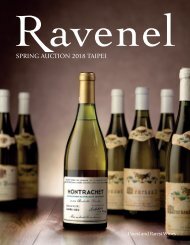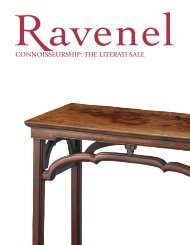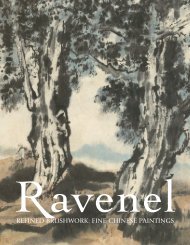亞洲現代與當代藝術 Modern and Contemporary Asian Art
羅芙奧2018春季拍賣會 亞洲現代與當代藝術 Ravenel Spring Auction 2018 Modern and Contemporary Asian Art
羅芙奧2018春季拍賣會 亞洲現代與當代藝術 Ravenel Spring Auction 2018 Modern and Contemporary Asian Art
Create successful ePaper yourself
Turn your PDF publications into a flip-book with our unique Google optimized e-Paper software.
“I dare say my painting is a romantic one. It brings me the greatest happiness.<br />
The most powerful happiness is painting itself.” - Zao Wou-Ki<br />
that mattered. Remembering his passion for creation at that time,<br />
Zao said, "I dare say my painting is a romantic one. It brings me the<br />
greatest happiness. The most powerful happiness is painting itself."<br />
(J'avoue, sans complexe, avoir fait une peinture romantique qui m'apporta de très<br />
gr<strong>and</strong>es joies et la plus forte, celle de peindre de la peinture.) (Zao Wou-ki & Françoise<br />
Marquet, Autoportrait, Fayard, Paris, 1986, pp. 121)<br />
According to art critic Jean Leymarie in Catalogue Raisonné, the<br />
first edition in French, Zao continuously developed his art in the<br />
1960s, employing methods of contractor harmony <strong>and</strong> of ten<br />
presenting the rhythm<br />
of the picture, its texture<br />
<strong>and</strong> color modulation.<br />
There is a preference for<br />
monochromatic colors<br />
which are occasionally<br />
dark <strong>and</strong> rich; the uneven<br />
brown shade shows black<br />
scrape marks which are<br />
opalescent <strong>and</strong> light at<br />
times. An example is<br />
the silver gray brume.<br />
Other examples include<br />
snow <strong>and</strong> sapphire,<br />
mousse <strong>and</strong> rubious<br />
sumptuous accords (Jean<br />
Leymarie, Zao Wouki,<br />
edition Cercled' art,<br />
Paris, 1978, 1986, p. 40).<br />
What Leymarie refers<br />
to is the rich variation<br />
in shade <strong>and</strong> the varied<br />
texture. As Zao was<br />
meticulously perceptive<br />
<strong>and</strong> full of emotions, <strong>and</strong><br />
because his paintings<br />
originate from his feelings<br />
about life, his emotional<br />
fluctuation is naturally revealed in his paintings, which are also his<br />
harbor of refuge in times of distress. Zao once said that his painting<br />
was his diary <strong>and</strong> his life. <strong>Art</strong> historians consider his works as<br />
sentimental abstract paintings. Like poetry, they have a perceptual<br />
existence yet they are not abstruse or pedantic.<br />
The imposing <strong>and</strong> vivid "5.11.62" shows the seascape in a<br />
horizontal frame, which is the most typical form employed by<br />
the artist in the 1960s. The painting is divided into three parallel<br />
sections. The near ocher top <strong>and</strong> bottom portions are in harmony<br />
with the bronze-colored space, one being static <strong>and</strong> the other<br />
dynamic. The middle section is bright yellow <strong>and</strong> green, with<br />
light emerging from the center of the picture. Black lines shuttle<br />
in between like shadows left behind by the rapid movement,<br />
forming a pulling <strong>and</strong> pushing force in the actual situation. Zao's<br />
perfect use of space <strong>and</strong> light source, as well as his high spirits,<br />
can be observed in "5.11.62". As he puts it in his autobiography,<br />
"The large canvas means I have to battle with space. Not only do I<br />
have to fill it, I must give it life <strong>and</strong> throw myself into it completely.<br />
I want to show movement, a lingering circuit, or the whipping<br />
movement of wind <strong>and</strong> lightning. I want to make the canvas come<br />
alive through contrast <strong>and</strong> the action of multiple layers of similar<br />
colors. I want to find a center for the radiation of light." (Les gr<strong>and</strong>es<br />
surfaces me dem<strong>and</strong>aient de me batter avec l'espace; je devais impérativement remplir<br />
cette surface, la faire vivre et me donner à elle. Je cherchais à exprimer le movement, sa<br />
lenteur lancinante ou sa fulgurance, je voulais faire vibrer la surface de la toile grâce aux<br />
contrastes ou aux multiples frémissements d'une même couleur. Je cherchais un centre<br />
qui irradie.) (Autoportrait of Zao Wou-ki)<br />
In "5.11.62", the artist pours out his feelings <strong>and</strong> aspirations in<br />
life. The sentiments expressed in the painting reverberate with<br />
energy <strong>and</strong> are full of vigor. Rhythmic movements such as the<br />
wind <strong>and</strong> waves in nature give one a musical experience. In the<br />
dialogue of one- time poet Wai - lim Yip, Zao once pointed out the<br />
similarity between painting <strong>and</strong> music, which must cease <strong>and</strong> be<br />
still in order to become music, <strong>and</strong> not consist of incessant sounds.<br />
Having learned music for six years, Zao is especially careful with<br />
light source, space <strong>and</strong> the abstract nature of music, linking them<br />
together in an ingenious manner. Taiwanese art critic Tu Jo-chou<br />
once commended, "Chinese space <strong>and</strong> Western space are one of<br />
the noteworthy artistic achievements of Zao Wou-ki." He constantly<br />
integrates the potentials of the two great cultures, using their<br />
modern expressions <strong>and</strong> vocabulary not only to attain the spiritual<br />
journey but to create a whole new visual world as well.<br />
5.12.196920060609093<br />
ZAO Wou-ki, 5.12.1969, Ravenel Autumn Auction 2006, lot 060,<br />
NT$ 90,930,000 sold, 1969, oil on canvas, 194 x 96 cm<br />
136







